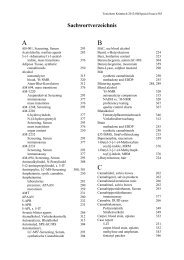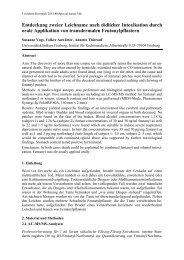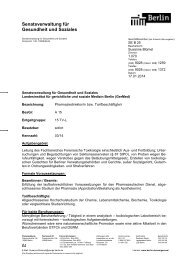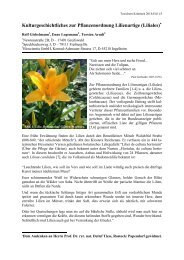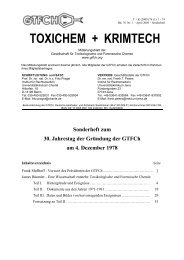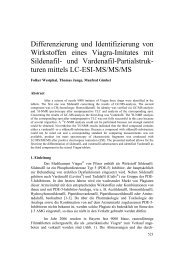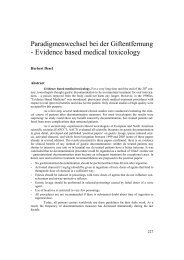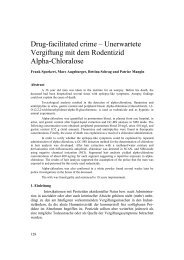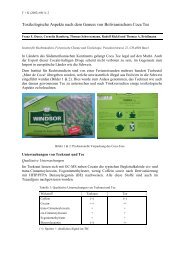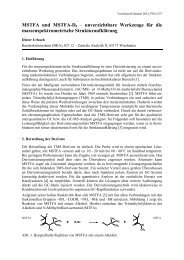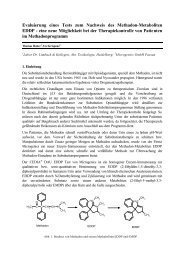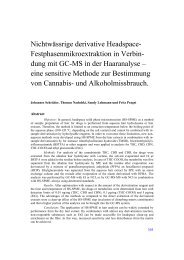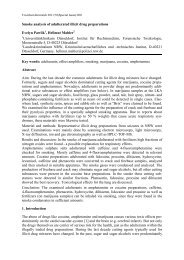In vitro UGT assay for inhibition studies of benzodiazepines ... - GTFCh
In vitro UGT assay for inhibition studies of benzodiazepines ... - GTFCh
In vitro UGT assay for inhibition studies of benzodiazepines ... - GTFCh
You also want an ePaper? Increase the reach of your titles
YUMPU automatically turns print PDFs into web optimized ePapers that Google loves.
<strong>In</strong> <strong>vitro</strong> <strong>UGT</strong> <strong>assay</strong> <strong>for</strong> <strong>inhibition</strong> <strong>studies</strong><br />
<strong>of</strong> <strong>benzodiazepines</strong> and opiates during<br />
phase II-metabolism<br />
T. Pallmann, K. Bender, G. Sticht, M.A. Rothschild, H. Käferstein<br />
<strong>In</strong>troduction<br />
Hydroxy-<strong>benzodiazepines</strong> and opiates are metabolized through glucuronidation<br />
which is the predominant pathway in the clearance mechanism <strong>of</strong> exogenous<br />
and endogenous substances during phase II-metabolism. The reaction is<br />
catalyzed by uridine-diphosphoglucuronyltransferases (<strong>UGT</strong>s) [1]. The presented<br />
work is motivated by the fact that the combination <strong>of</strong> <strong>benzodiazepines</strong> and opiates<br />
is common both in clinical practice and as combined abuse. <strong>In</strong>hibition <strong>of</strong> the glucuronidation<br />
can lead to a decelerated elimination <strong>of</strong> the phase I-metabolites,<br />
respectively <strong>of</strong> substances which are subjects <strong>of</strong> the phase II-metabolism. <strong>In</strong> the<br />
case <strong>of</strong> pharmacological and toxicological active substances, like the hydroxy<strong>benzodiazepines</strong><br />
and opiates, this can result in a prolonged pharmacological<br />
activity and in a higher risk <strong>of</strong> side effects <strong>of</strong> these substances [2, 3]. There<strong>for</strong>e an<br />
in <strong>vitro</strong> <strong>UGT</strong>-<strong>assay</strong> <strong>for</strong> <strong>inhibition</strong> <strong>studies</strong> between hydroxy-<strong>benzodiazepines</strong> and<br />
opiates has been developed and optimized using pooled human liver microsomes<br />
(HLMs).<br />
Methods<br />
For the investigation <strong>of</strong> the interaction capabilities <strong>of</strong> some <strong>benzodiazepines</strong><br />
and opiates during phase II-metabolism an in <strong>vitro</strong> <strong>assay</strong> was developed<br />
<strong>for</strong> oxazepam and temazepam (10-1000 µmol), morphine and codeine (2.5, 5 and<br />
10 mM) using pooled human liver microsomes (HLMs, BD Bioscience) with a<br />
total protein concentration <strong>of</strong> 1.0 mg/ml. As shown in Fig. 1, the maximum <strong>of</strong> the<br />
enzymatic activity <strong>of</strong> the <strong>UGT</strong>s was achieved at a pH <strong>of</strong> 9 using 50 mM Tris<br />
buffer, 40 °C, 8 mM UDPGA, and an incubation time <strong>of</strong> 240 min. It is striking,<br />
that the pH- and temperature-values do not reflect physiological conditions.<br />
There<strong>for</strong>e, the incubations were per<strong>for</strong>med at 37 o C in 50 mM Tris buffer (pH 7.4)<br />
with 5 mM MgCl 2 , 8 mM UDPGA, and alamethicin (50 µg/mg microsomal proteins)<br />
in a total volume <strong>of</strong> 100 µl <strong>for</strong> 240 min. After quenching <strong>of</strong> the enzymatic<br />
activity and centrifugation, the supernatant was analyzed by HPLC/DAD.<br />
165
22<br />
6000<br />
velocity (pmol/min/mg)<br />
20<br />
18<br />
16<br />
14<br />
12<br />
10<br />
8<br />
6<br />
4<br />
2<br />
Menge OG1/Protein (pmol/mg)<br />
5000<br />
4000<br />
3000<br />
2000<br />
1000<br />
0<br />
6 7 8 9 10 11 12<br />
pH<br />
0<br />
0 1 2 3 4 5 6<br />
time (h)<br />
50<br />
14<br />
40<br />
12<br />
velocity (pmol/min/mg)<br />
30<br />
20<br />
velocity (pmol/min/mg)<br />
10<br />
8<br />
6<br />
4<br />
10<br />
2<br />
0<br />
0 20 40 60<br />
temperature [C o ]<br />
0<br />
0 2 4 6 8 10 12 14 16 18<br />
UDPGA (mM)<br />
Fig. 1: The maximum <strong>of</strong> enzymatic activity <strong>of</strong> the <strong>UGT</strong>-enzyme superfamily could be<br />
archived at pH 9 in 50 mM Tris buffer, incubation time <strong>of</strong> 4 h, 40 °C and 8 mM<br />
and UDPGA.<br />
mAU<br />
Phenacetin<br />
25 Oxazepam<br />
Temazepam<br />
20<br />
15<br />
10<br />
5<br />
R-Oxazepam glucuronide<br />
S-Oxazepam glucuronide<br />
R-Temazepam glucuronide<br />
S-Temazepam glucuronide<br />
0<br />
5 10 15 20 25 30min<br />
Fig. 2: Chromatographic separation <strong>of</strong> the diastereomeric benzodiazepine-glucuronides<br />
and its aglycons. Phenacetin was used as internal standard.<br />
Chromatographic separation (Fig. 2) <strong>of</strong> the diastereomeric benzodiazepine<br />
glucuronides was possible using a RP-C 18 column (Spherisorb ODS2, 5 µm, 250 x<br />
4 mm, Trentec), an column oven temperature <strong>of</strong> 40 °C, and an isocratic mobile<br />
phase (flow rate 1.7 mL/min.) consisting <strong>of</strong> 0.3 % phosphoric acid (78 %),<br />
166
acetonitrile (16 %), and isopropanol (6 %). For morphine-3- and morphine-6-<br />
glucuronide a mobile phase consisting <strong>of</strong> 98 % 10 mM phosphoric acid (pH 2.7)<br />
and 2 % acetonitrile was used and <strong>for</strong> codeine-6-glucuronidethe concentration<br />
was 93 % 10 mM phosphoric acid (pH 2.7) and 7 % acetonitrile.<br />
Results<br />
K m and V max values have been evaluated <strong>for</strong> both enantiomers <strong>of</strong><br />
temazepam and oxazepam with two batches <strong>of</strong> HLMs (Fig. 3).<br />
50<br />
velocity (pmol/min/mg)<br />
40<br />
30<br />
20<br />
10<br />
S-Oxazepam: Substrate <strong>inhibition</strong> model<br />
K m = 28.8 µM<br />
V max = 54.9 pmol/min/mg<br />
R-Oxazepam: Michaelis Menten model<br />
K m = 90.7 µM<br />
V max = 25.1 pmol/min/mg<br />
(A)<br />
(B)<br />
0<br />
0 200 400 600 800 1000 1200<br />
Oxazepam (µM)<br />
100<br />
velocity (pmol/min/mg)<br />
80<br />
60<br />
40<br />
20<br />
S-Temazepam: Substrate <strong>inhibition</strong> model<br />
K m = 82.9 µM<br />
V max = 83.7 pmol/min/mg<br />
R-Temazepam: Michaelis Menten model<br />
K m = 370.2 µM<br />
V max = 110.2 pmol/min/mg<br />
(C)<br />
(D)<br />
0<br />
0 200 400 600 800 1000 1200<br />
Temazepam (µM)<br />
Fig. 3: Enzyme kinetic data <strong>of</strong> S-oxazepam (A), R-oxazepam (B), R-temazepam (C),<br />
and S-temazepam using HLMs.<br />
167
The results show that the K m values <strong>for</strong> S-oxazepam (28.8+/-5.3 and<br />
37.1+/-9.6 µmol) and S-temazepam (77.4+/-12.6 and 82.9+/-7.7 µmol) were<br />
lower than <strong>for</strong> R-enantiomers (R-oxazepam (90.7+/-12.6 and 104.9+/-10.6 µmol),<br />
R-temazepam (336.4+/-37.6 and 370.2+/-94.6 µmol)). The determined K m -values<br />
<strong>of</strong> R- and S-oxazepam indicating a higher affinity to the <strong>UGT</strong>-enzyme<br />
superfamily as the enantiomers <strong>of</strong> temazepam. Furthermore the measured<br />
K m -values are indicating a higher <strong>UGT</strong>-affinity <strong>of</strong> the S-enantiomers unlike the R-<br />
enantiomers <strong>of</strong> the <strong>benzodiazepines</strong> oxazepam and temazepam. <strong>In</strong>hibition <strong>studies</strong><br />
between the <strong>benzodiazepines</strong> oxazepam, temazepam and the opiates morphine and<br />
codeine as inhibitors showed that the K i -values <strong>for</strong> S-enantiomers are smaller than<br />
<strong>for</strong> R-enantiomers, which is exemplarily shown in Fig. 4.<br />
velocity(pmol/min/mg)<br />
25<br />
20<br />
15<br />
10<br />
5<br />
(A)<br />
1/velocity(pmol/min/mg)<br />
0,8<br />
0,6<br />
0,4<br />
0,2<br />
(B)<br />
velocity(pmol/min/mg)<br />
0<br />
0 50 100 150 200 250 300<br />
40<br />
35<br />
30<br />
25<br />
20<br />
15<br />
10<br />
5<br />
(C)<br />
(R,S) Oxazepam (µM)<br />
-0,010 -0,005 0,000 0,005 0,010 0,015 0,020 0,025<br />
1/velocity(pmol/min/mg)<br />
0,12<br />
0,10<br />
0,08<br />
0,06<br />
0,04<br />
0,02<br />
1/(R,S) Oxazepam (µM)<br />
(D)<br />
0<br />
0 50 100 150 200 250 300<br />
(R,S) Oxazepam (µM)<br />
-0,02 -0,01 0,00 0,01 0,02 0,03<br />
1/(R,S) Oxazepam(µM)<br />
Fig. 4: Michaelis-Menten plot (left) and Lineweaver-Burk plot (right) <strong>of</strong> R-oxazepam (A/B) and<br />
S-oxazepam (C/D) inhibited by 0 µM (-●-), 2.5 µM (-○-), 5.0 µM (-▼-), and 10.0 µM (-∇-)<br />
morphine.<br />
By using the <strong>benzodiazepines</strong> as inhibitors, temazepam showed the highest<br />
inhibitory effect on the glucuronidation <strong>of</strong> morphine, whereas oxazepam inhibited<br />
the codeine glucuronidation most. <strong>In</strong> addition, the glucuronidation <strong>of</strong> codeine was<br />
much more affected by the <strong>benzodiazepines</strong> than it was observable <strong>for</strong> morphine.<br />
168
Conclusion<br />
With the developed and optimized in <strong>vitro</strong> <strong>assay</strong>, consisting <strong>of</strong> pooled<br />
human liver microsomes, it was possible to analyze the interaction potentials<br />
between the hydroxy-<strong>benzodiazepines</strong> oxazepam and temazepam and the opiates<br />
morphine and codeine. Furthermore it was possible to consider the enantiomer<br />
specific differences <strong>of</strong> the benzodiazepine-glucuronidation. The results show that<br />
S-enantiomers <strong>of</strong> the <strong>benzodiazepines</strong> exhibit a higher affinity to the <strong>UGT</strong>s than<br />
the R-enantiomers do. This can be deduced from the lower K m -values <strong>of</strong> the<br />
S-enantiomers compared to the R-enantiomers. The glucuronidation <strong>of</strong> morphine<br />
was more negatively affected by temazepam than by oxazepam. <strong>In</strong> addition to<br />
these findings the <strong>benzodiazepines</strong> exhibits a higher inhibitory effect on the<br />
codeine glucuronidation as on the morphine glucuronidation. Furthermore, the<br />
codeine itself is a stronger inhibitor <strong>of</strong> the benzodiazepine-glucuronidation<br />
compared to morphine. <strong>In</strong> particular, the glucuronidation <strong>of</strong> the S-enantiomers are<br />
more affected by the opiates than the R-enantiomers. This is feasible by the fact<br />
that the S-enantiomers exhibits a higher <strong>UGT</strong>-affinity as mentioned be<strong>for</strong>e. It is<br />
thought, that S-oxazepam is more active on the GABA A -receptor than R-<br />
oxazepam [4]. Due to this, it can be derived that the <strong>inhibition</strong> <strong>of</strong> the S-<br />
enantiomer glucuronidation <strong>of</strong> the <strong>benzodiazepines</strong> by morphine and codeine can<br />
contribute to the side effects <strong>of</strong> the <strong>benzodiazepines</strong>.<br />
<strong>In</strong> fact, <strong>UGT</strong>-catalyzed metabolic reactions account <strong>for</strong> about 35 % <strong>of</strong> all<br />
drugs which undergo phase II-metabolism [5]. Assuming, there is a high number<br />
<strong>of</strong> other substances which can at least partly inhibit the glucuronidation, drug<br />
interactions based on inhibitory effects during the phase II-metabolism, becomes<br />
obvious [2, 3].<br />
The presented work was financially supported by the Koeln Fortune<br />
Program / Faculty <strong>of</strong> Medicine, University <strong>of</strong> Cologne, Grants 51/2005 and<br />
68/2006. Full paper version will be published in an additional journal.<br />
References<br />
[1] King, C. D.; Rios, G. R.; Green, M. D.; Tephly, T. R., UDP-glucuronosyltransferases.<br />
Current Drug Metabolism 2000, 1, (2), 143-161.<br />
[2] Kiang, T. K. L.; Ensom, M. H. H.; Chang, T. K. H., UDP-glucuronosyltransferases and<br />
clinical drug-drug interactions. Pharmacology & Therapeutics 2005, 106, (1), 97-132.<br />
[3] Lin, J. H.; Wong, B. K., Complexities <strong>of</strong> glucuronidation affecting in <strong>vitro</strong>-in vivo<br />
extrapolation. Current Drug Metabolism 2002, 3, (6), 623-646.<br />
[4] Mohler, H.; Okada, T.; Heitz, P.; Ulrich, J., Biochemical Identification Of Site Of Action Of<br />
Benzodiazepines <strong>In</strong> Human-Brain By Diazepam-H-3 Binding. Life Sciences 1978, 22, (11),<br />
985-995.<br />
169
[5] Evans, W. E.; Relling, M. V., Pharmacogenomics: translating functional genomics into<br />
rational therapeutics. Science 1999, 286, 487-491.<br />
Dr. Katja Bender<br />
<strong>In</strong>stitut für Rechtsmedizin<br />
Klinikum der Universität zu Köln<br />
E-Mail: katja.bender@uk-koeln.de<br />
170



